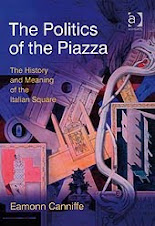
As is well known, in 1585 pope Sixtus V charges Fontana with restructuring the city of Rome as a part of the counter-reformist agenda of the Catholic Church. In the period of five years -— for Sixtus's papacy turned out to be that short -— Fontana succeeds in doing something which today we might describe as re-inventing the city. His vision, unmistakably revealed in a well-known drawing, no longer deals with the city as a static, controlled object . Rather, the city is conceived of as a network. Urban spaces become nodes, identified by the vertical markers of obelisks and columns, and these are tied together with a web of straight streets, "tunnels of vision" intended to drive one onward to the next nodal space.

Fontana's intervention is amply documented and discussed in the literature, but the significance of his conceptual leap is not. For example, as late as 1963, such a respected historian as Henry Millon would write that "we have yet to have a clear picture as to what Fontana and Sixtus the Fifth intended with their streets and obelisks 6." Yet the consequences of Fontana's and Sixtus's work for a new idea of the city seem apparent. First, operating on the city is not an activity in which all the elements of a spatial composition are controlled, as they would be in a building, but an undertaking in which a hierarchical framework functions as the structure for incremental development, growth, and change. Second, the intimate connection between city shape and movement flow becomes the generator of urban form, intended to respond to the increasingly pressing need to communicate and transport, not just to be an assemblage of spaces. And finally, the realization begins to emerge that the city, because of its complex nature, requires new rules and structures that can manage both its administrative and spatial aspects.

This conception is not independent from architectural control of elements and spaces woven into the urban network. On the contrary, architecture provides the means by which nodes and connections acquire spatial presence, as the great squares of baroque Rome illustrate.
Fontana's brilliant intuition foreshadows a conception of the city that increasingly reflects reality in today's world.
Extracted from
Guido Francescato City as Home and City as Network: Contrasting Paradigms in History


No comments:
Post a Comment